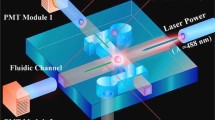Abstract
An optical sensor combined total analysis system (TAS) is thought to be one of the most effective functional elements in realizing a ubiquitous human healthcare system. In accordance with this concept, we have proposed a fundamental structure of a light-wave-guide incorporated TAS and have developed a micro fluidic channel fabricated chip, where two light waveguides having approximately 10-μm cores were facing each other across a fluidic channel with a width of 12 μm. By passing 5-μm-diameter polystyrene particles across the portion where a light-wave-guide and the fluidic channel intersect at a right angles, we confirmed that changes to transmitted light and scattered light were detectable even with an extremely low laser source power of 5 μW, and they increased proportionally as the introduced laser power became higher. Increasing the introduced laser power clearly increased the correlation between the transmitted and scattered light change. Here we discuss in detail the two different correlation tendencies that appeared in the correlation maps.











Similar content being viewed by others
References
Gregor NF (2002) Device and method for investigating analysis in liquid suspension or solution, International Application Published under the Patent Cooperation Treaty (PCT), PCT/GB02/05567
Mapps T, Vannahme C, Schelb M, Lemmer U, Mohr J (2009) Design for optimized coupling of organic semiconductor laser light into polymer waveguides for high integrated biophotonic sensors. Microphotonic Eng 86:1499–1501
Ohkubo T, Hashimoto M, Hirota T, Itao K, Niwa T, Maeda H, Mitsuoka Y, Nakajimka K (2000) Mechanical characteristics of an optical flying-head assembly with visible light-wave guide flexure. J Inf Storage Process Syst 2:323–330
Okagbare PI, Emoey LM, Datta P, Goettert J, Soper SA (2010) Fabrication of cyclic olefin copolymer waveguide embedded in a multi-channel poly(methyl methacrylate) fluidic chip for evanescence excitation, Lab. Chip 10:66–73
Takahashi N, Aki A, Ukai T, Nakajima Y, Maekawa T, Hanajiri T (2009) Electrophoretic mobility and resultant zeta potential of an individual cell analyzed by electrophoretic counter method, Int. Symp. Semiconductor Device Research Symposium (Washington, DC, December 2009), WP4-03
Vazquez RM, Osellame R, Nolli D, Dongre C, Vlekkert Hvd, Ramponi R, Pollnau M, Cellulo G (2009) Integration of femtosecond laser written optical waveguides in a lab-on-chip. Lab Chip 9:91–96
Yamada H, Yoshida Y, Terada N, Hagiwara S, Komatsu T, Terasawa A (2009) Laser fabrication of a micro-fluidic device for a blood cell counter, Proceedings of Autumn Annual Meeting. Jpn Soc Precis Eng G64:543–544
Acknowledgments
Assistance for this research was provided by a Grant-in-aid for a high technology research project promoted by the Ministry of Education, Culture, Sports, Science and Technology Japan. The authors thank Dr. Makoto Hikita and Dr. Saburo Imamura, NTT Advanced Technology Corp., for their useful technical advice in designing a resin-based optical TAS structure and their suggestions about a method of observing a transparent light-wave-guide core.
Author information
Authors and Affiliations
Corresponding author
Rights and permissions
About this article
Cite this article
Ohkubo, T., Terada, N. & Yoshida, Y. Minute particle detection using a light-wave-guide incorporated optical total analysis system. Microsyst Technol 17, 849–856 (2011). https://doi.org/10.1007/s00542-011-1263-5
Received:
Accepted:
Published:
Issue Date:
DOI: https://doi.org/10.1007/s00542-011-1263-5




